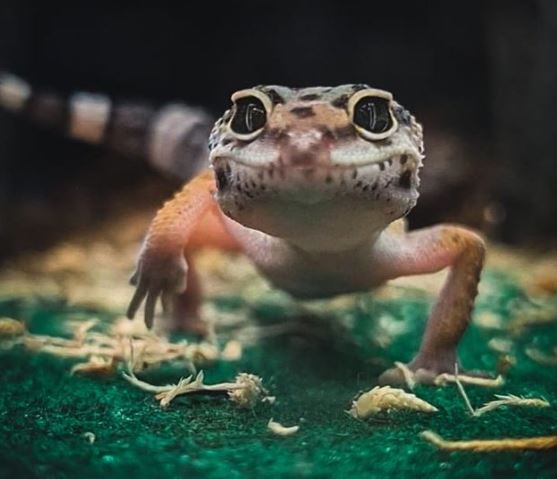Why should you know how to install a reptile pet carpet? Adding a reptile carpet to your terrarium can be a very nice touch.
It does not only look good as an alternative flooring but it also provides vital thermal insulation as well as comfort for the animals.
In this article, I’ll show you how to install a reptile carpet properly in your terrarium.
Related Posts:
- Best Heat Mats for Leopard Gecko
- Top 7 Leopard Gecko Starter Kits for Easy Setup
- Best Substrate for Bearded Dragons
- How Often Should You Clean a Reptile Carpet?
- How to Turn an Aquarium Into a Reptile Terrarium?
How to Install a Reptile Carpet?
In our case, we’re using a common European leopard gecko.
For other species, you should take into account what kind of reptile carpet material is recommended so it cannot be eaten by your animals and that it can withstand the natural behavior of reptiles such as digging or climbing on top of it.
If this is not the case, I would recommend picking another substrate instead.
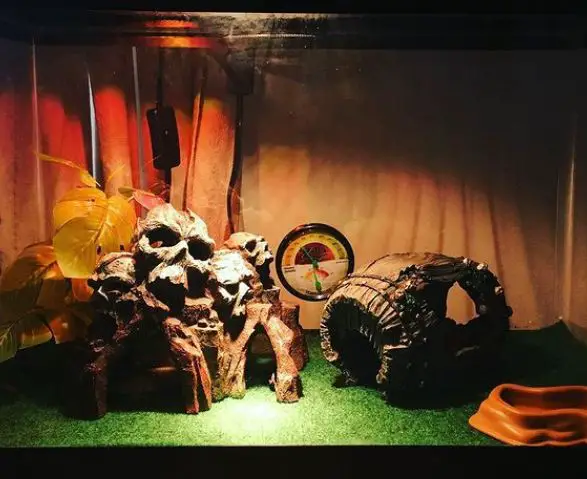
1. Prepare the Reptile Carpet
So, to install a reptile carpet, the first step is choosing the carpet you want to use.
I’m using a piece of reptile carpet that measures roughly 30cm by 45cm.
It’s a little too big for a single leopard gecko, but it can be used as an alternative flooring or does not necessarily have to go on top of the bottom of the terrarium.
To make it more stable, I’m using some gravel underneath.
2. Cut the Reptile Carpet to Fit in the Terrarium
Then, I simply fold the carpet in half and cut it roughly to size so that it fits within the back wall of the terrarium.
It should be slightly smaller than the wall so your animals cannot climb up on top of it easily.
But you have to make sure not to cut off too much material so that the carpet would stay in place without gravel underneath.
It does not matter if it’s a little bit longer and sticks out of the terrarium.
Tweak the edges by folding them over and giving them some shape.
This will make your carpet look more natural once you put it on top of the substrate inside of your terrarium.
3. Pour Sand Over the Reptile Carpet
Now, we’re going to apply a thin layer of the substrate directly onto our reptile carpet. I’m using the same kind of sand that I would recommend for leopard geckos (i.e., Calci-sand or Plantation soil).
Simply pour some sand over your folded-up carpet and work it in with your fingers by massaging it into the material. This way, you’ll get a nice and even coating of sand across the whole surface.
But make sure not to add too much, or else, it will fall through when you place your terrarium on top of it later on!
4. Cut Another Piece of the Reptile Carpet
Once the first layer is applied, I take another piece of reptile carpet, which should also be cut down to size so it fits within the back wall of your terrarium.
I apply a second layer using the same technique as before but, this time, moving it to the opposite direction so that you get an attractive pattern showing through on top of your substrate as well as a nice natural look once everything is finished.
5. Cut Another Piece and Pour More Sand
Now, we’re going to add our third and final layer onto the substrate inside our terrarium.
Once again, I use another piece of reptile carpet and repeat the step before by applying a thin layer of sand and “massaging” it into the material (image below shows bottom-view).
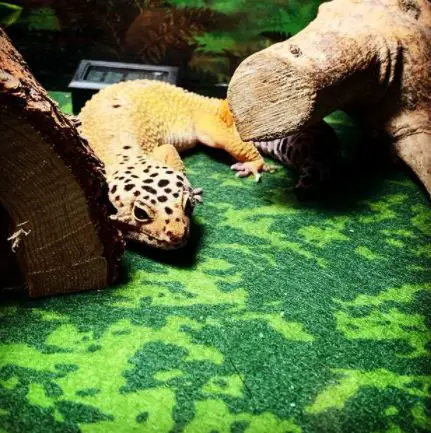
Make sure not to push too hard. Otherwise, you might hurt yourself or damage the material itself!
Be careful, especially when using Calci-sand, because it’s very light compared to soil and has a very sharp and abrasive surface.
6. Finish It
You should end up with something similar to the image below once you’re done applying all three layers of the substrate to your terrarium.
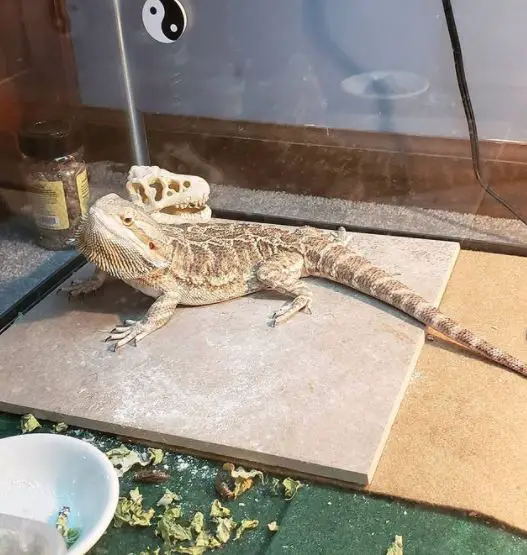
Now, simply place your terrarium on top of it, put in some gravel at the bottom for thermal insulation, create an appropriate backdrop using branches or rocks as well as add any background plants that are suitable for this type of environment!
Your nice new reptile carpet has been successfully applied to the substrate inside of your gecko’s home! Hopefully, this guide on how to install a reptile carpet has made the process easy for you!
What Is a Reptile Carpet Made of?
A product called Repti-Carpet is a more recent variation of reptile cages that have been around for a very long time.
They are made by using a building material commonly used in the construction industry, more specifically carpet underlay, and gluing it to a piece of plastic mesh.
It has all the benefits of being really cheap but at the same time can be hard to clean and easy for reptiles to get caught up in.
The original idea was probably quite good, but perhaps not so well executed. I guess you get what you pay for!
Do Reptiles Really Need a Carpet?
Reptiles need high humidity, so there is no point in having an open substrate that will dry out too quickly, which is why a lot of people use substrates such as newspaper or artificial turf.
However, there are some species that burrow and may ingest substrate when foraging.
Some reptiles such as crested geckos find their way into this type of cage and remain in hiding all day long.
If you want to see them, you need to switch the lights on, which will put them in a better mood at least!
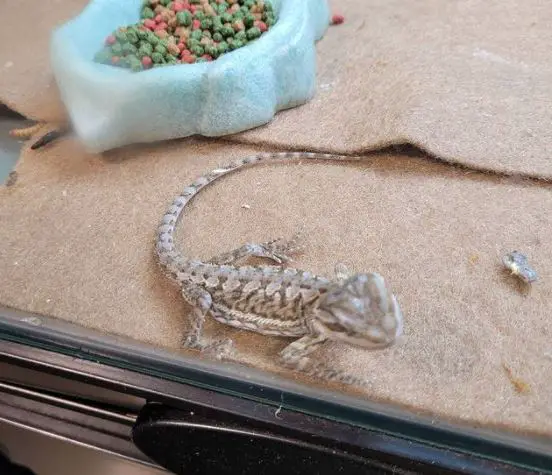
What Are Some Reptile Carpet Alternatives?
1. Newspaper or Paper Towels for Reptiles
Recently, I have found that raw white bread, paper towels, and newspaper are good for reptiles as a substrate. It gives them something to dig in and it absorbs odors very well.
I use the newspaper simply because it’s easier on my wallet and the environment (hey, we all know how many trees they cut down yearly) and I can get a giant pack of newspapers for about $4.00!
Paper towels, on the other hand, I use instead of kitchen roll, which is a lot more expensive and can be made from recycled materials.
So, why not use paper towels? Because they don’t soak up water as well and my snakes tend to get them caught around their feet.
The newspaper absorbs water. Not to mention, it can easily be replaced if there’s an accident.
My snakes seem to enjoy digging around in the wet newspaper, which is another plus side.
What about your carpet? Why not just use that instead of buying a snake carpet from the pet shop?
2. Ceramic Tiles for Reptiles
Ceramic tiles are very easy to clean and dry out quickly. They come in a variety of colors (my favorite is white) and they soak up water nicely. Plus, I love the look of them.
If you don’t like the idea of tiles because they seem cold, you can always get some kind of bedding your snake can burrow into. Reducing the visual doesn’t mean reducing the sense of touch.
Snakes don’t care what they’re lying on. They can sleep through anything.
3. Rubber Shelf Liner for Reptiles
This is probably something you will have around the house anyway.
It absorbs water fantastically and it’s really easy to clean up any accidents your snake might have.
Not only that but if you don’t use the whole roll, the rubber shelf liner can be cut into strips or whatever size/shape you think of.
You can easily replace the old with the new, and because it absorbs so well, it doesn’t leave any puddles around.
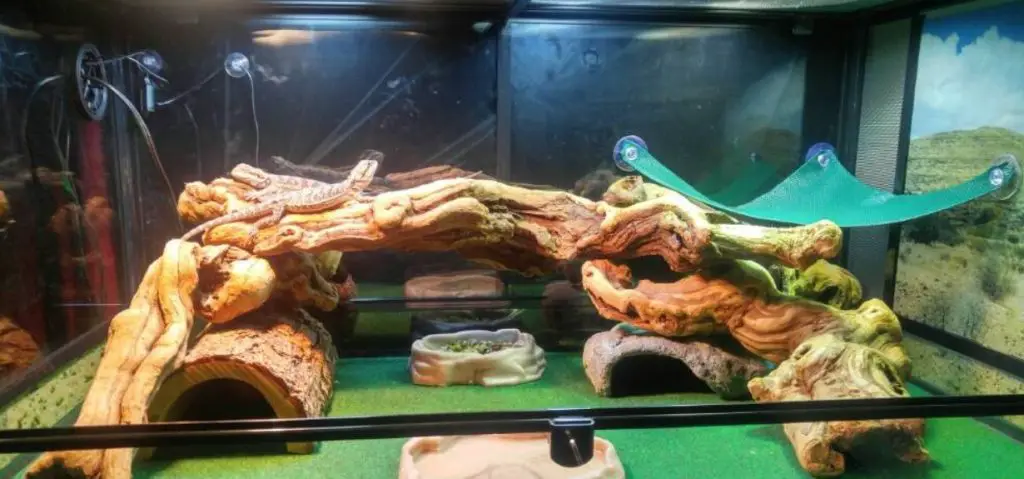
4. Alfalfa Pellets for Reptiles
This one is something I haven’t tried yet, but it’s something that should be mentioned. Alfalfa pellets are also another great substrate for snakes.
It’s like it’s made especially for them! Although you need to make sure that your snake will eat the alfalfa before using this as a substrate.
Snakes can die if they eat substrate! Make sure to research alfalfa pellets before trying this one.
5. Stones for Reptiles
This works well as a substrate because it soaks up water and is easily replaceable.
However, some snakes may ingest the stones thinking it’s food. It also depends on where you live because certain types of stone can be toxic depending on your region.
Be sure to do some research before trying this one out.
Conclusion
Reptile carpet is the perfect solution for pet owners who want to provide their pets with a soft, warm surface that also looks great.
It’s easy to install and provides an attractive area rug, which you can use in any room of your home or office.
Key points to remember about how to install reptile carpet:
Reptile carpet is a popular substrate choice for reptile enclosures because it’s easy to clean and safe for your pets. Here’s a step-by-step guide to help you install reptile carpet in your reptile habitat:
Materials Needed:
- Reptile Carpet: Purchase a reptile carpet of the appropriate size for your enclosure.
- Scissors: You’ll need scissors to trim the carpet to fit the enclosure’s dimensions.
- Double-Sided Tape (Optional): This can help secure the carpet in place.
Installation Steps:
- Measure and Cut:
- Measure the dimensions of your reptile enclosure, including the length and width.
- Unroll the reptile carpet and use the measurements to cut it to the appropriate size with scissors. Make sure it fits snugly inside the enclosure.
- Clean the Enclosure:
- Before placing the reptile carpet, thoroughly clean the enclosure to remove any old substrate, debris, or waste. This step ensures a hygienic environment for your reptile.
- Lay the Carpet:
- Gently place the cut reptile carpet into the enclosure, ensuring it covers the entire floor area. You can use double-sided tape on the corners or edges for added security if necessary.
- Smooth It Out:
- Smooth out any wrinkles, bubbles, or creases in the carpet to create an even surface. This ensures a comfortable and safe environment for your reptile.
- Secure or Trim Edges:
- If using double-sided tape, secure the edges or corners of the carpet to prevent your reptile from digging it up.
- Trim any excess carpet if it extends beyond the enclosure’s edges.
- Place Furnishings:
- Reintroduce your reptile’s habitat furnishings, such as hides, water dishes, and basking spots, on top of the carpet.
Maintenance Tips:
- Spot Cleaning:
- Regularly inspect and spot clean the reptile carpet. Remove waste, shed skin, or any soiled areas as needed.
- Full Cleaning:
- Depending on your reptile’s habits, perform a complete cleaning of the reptile carpet every few weeks.
- Remove your reptile, furnishings, and the carpet from the enclosure.
- Shake or vacuum the carpet to remove debris and waste.
- If necessary, wash the carpet using a reptile-safe disinfectant or soap and water. Rinse thoroughly to remove any residue.
- Allow the carpet to dry completely before placing it back in the enclosure.
- Replacement:
- Over time, reptile carpet can wear out or become damaged. It’s advisable to replace it when it shows signs of excessive wear, fraying, or stubborn staining.
Conclusion:
Installing and maintaining reptile carpet in your reptile enclosure can create a clean and safe environment for your pets. Regular cleaning and replacement when necessary are essential for keeping the habitat hygienic and comfortable. Following these steps and practicing proper reptile care will ensure a healthy and happy home for your cold-blooded companions.
Further Reading:
- Best Turtle Substrate for Your Pet Tank
- Best Substrate for Russian Tortoise
- 6 Best Substrate for Leopard Tortoise

